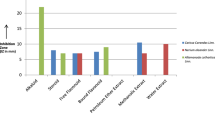Abstract
Objective
To investigate the antifungal activities of the extracts and sub-fractions of Phlomis olivieri, Verbascum speciosum, Sambucus ebulus and Erigeron hyrcanicus, four Persian medicinal plants used in Iranian folk medicine.
Methods
Evaluation of the antifungal activity was performed on the clinical isolates of pathogenic fungi including Aspergillus fumigatus, A. flavus, Trichophyton mentagrophytes, T. rubrum, T. verrucosum, Microsporum canis, M. gypseum and Epidermophyton floccosum, and the yeast Candida albicans. The susceptibility tests were done by agar well diffusion method. The minimum inhibitory concentration (MIC) and minimum fungicidal concentration (MFC) of active extracts and sub-fractions were measured using method of National Committee for Clinical Laboratory Standards (NCCLS).
Results
Only P. olivieri sub-fractions were found to have fungicidal activity among the other investigated plants. The MIC and MFC was found to be high in petroleum ether, chloroform and ethyl acetate fractions (100 and 200 mg/mL) against the studied pathogenic fungi and the yeast Candida albicans. P. olivieri sub-fractions significantly inhibited the growth of all pathogenic fungi and the yeast studied.
Conclusion
If the antifungal activity of P. olivieri is confirmed by in vivo studies and if the responsible compound (s) is isolated and identified, it could be a good remedy for mycotic infections.
Similar content being viewed by others
References
Heinrich M, Barnes J, Gibbons S, Williamson EM. Fundamentals of pharmcognosy and phytotherapy. Elsevier science Ltd., Oxford; 2004;78.
Calixto JB. Twenty-five years of research on medicinal plants in Latin America: a personal view. J Ethnopharmacol 2005;100:131–134.
Kim JD, Kang SM, Park MY, Jung TY, Choi HY, Ku SK. Ameliorative anti-diabetic activity of dangnyosoko, a Chinese herbal medicine, in diabetic rats. Biosci Biotechnol Biochem 2007;71:1527–1534.
Halerstein RA. Medicinal plants: Historical and crosscultural usage patterns. Ann Epidemiol 2005;15:686–699.
Vaijayantimala J, Rajendra Prasad N, Pugalendi KV. Antifungal activity of oils. Indian J Microbiol 2001;41:325–328.
Beentje HJ, ed. Moringaceae. In: Kenya trees shrub and Lianas. Nairobi: Majestic Printing Works Ltd.;1994:37, 63.
Council of Europe. European pharmacopoeia, 4th ed. Strasbourg; 2001:93–99.
MacFaddin JF. Biochemical tests for identification of medical bacteria, 3rd ed. Philadelphia: Lippincott Williams & Wilkins;2000:825–826.
Chuang PH, Lee CW, Chou JY, Murugan M, Shieh BJ, Chen HM. Anti-fungal activity of crude extracts and essential oil of Moringa oleifera Lam. Biores Technol 2007;98:232–236.
Irobi ON, Darambolo SO. Antifungal activity of crude extracts of Mitracarpus villosus (Rubiaceae). J Ethnopharmacol 1993;40:137–140.
Rechinger KH. Flora Iranica. Graz: Druck-u Academic Publisher;1982:292–313.
Mohajer M, Sarkhail P, Hajarolasvadi N, Zamani MJ, Khorasani R, Shafiee A, et al. Antiinflammatory and analgesic effects of Phlomis lanceolata Boiss. and Hohen. extracts and examination of their components. Int J Pharmacol 2006;2:50–54.
Sarkhail P, Amin G, Surmaghi MHS, Shafiee A. Composition of the volatile oils of Phlomis lanceolata Boiss. & Hohen., Phlomis anisodonta Boiss. and Phlomis bruguieri Desf. from Iran. Flavour Fragra J 2005;20:327–329.
Sarkhail P, Monsef-Esfehani HR, Amin GR, Salehi Surmaghi MH, Shafiee A. Phytochemical study of Phlomis oivieri Benth. and Phlomis persica Boiss. Daru J Pharm Sci 2006;14:115–121.
Mirza M, Baher Nik Z. Volatile constituents of Phlomis olivieri Benth. from Iran. Flav Frag J 2003;18:131–132.
Limem-Ben Amor I, Boubaker J, Ben Sgaier M, Skandrani I, Bhouri W, Neffati A, et al. Phytochemistry and biological activities of Phlomis species. J Ethnopharmacol 2009;125:183–202.
Acknowledgments
Supports from the Pharmaceutical Sciences Branch, Islamic Azad University (IAU) are gratefully acknowledged.
Author information
Authors and Affiliations
Corresponding author
Rights and permissions
About this article
Cite this article
Asgarpanah, J., Hashemi, S.J., Hashemi, E. et al. In vitro antifungal activity of some traditional Persian medicinal plants on pathogenic fungi. Chin. J. Integr. Med. 23, 433–437 (2017). https://doi.org/10.1007/s11655-015-2181-7
Received:
Published:
Issue Date:
DOI: https://doi.org/10.1007/s11655-015-2181-7




